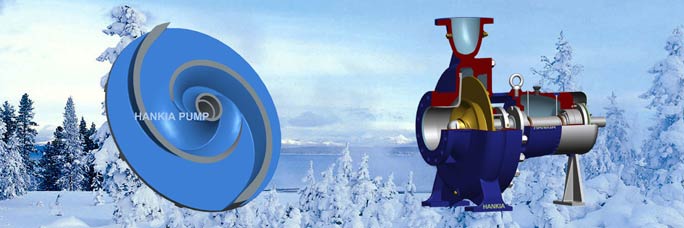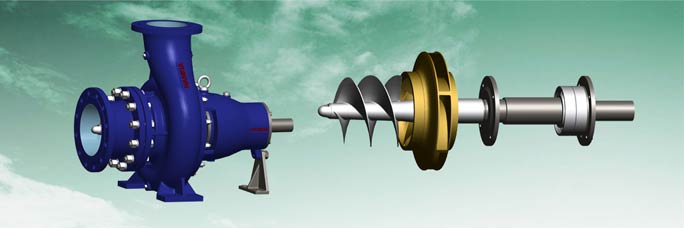Pump technology
- Pump viscosity correction
- Impeller cuts
- How to change the pump performance
- Centrifugal pump introduction
- Cavitation
- Right impeller selection
- Pump installation
- Vertical turbine pump
- Tops for specifying pumps
- Determine between end suction pump and double suction pump
- Understanding the NPSH
- Axially split case pump
Pump category
Centrifugal pump introduction
Centrifugal pumps are a sub-class of dynamic axisymmetric work-absorbing turbomachinery. Centrifugal pumps are used to transport fluids by the conversion of rotational kinetic energy to the hydrodynamic energy of the fluid flow. The rotational energy typically comes from an engine or electric motor. In the typical case, the fluid enters the pump impeller along or near to the rotating axis and is accelerated by the impeller, flowing radially outward into a diffuser or volute chamber (casing), from where it exits.
Common uses include water, sewage, petroleum and petrochemical pumping. The reverse function of the centrifugal pump is a water turbine converting potential energy of water pressure into mechanical rotational energy.
Working principles
Like most pumps, a centrifugal pump converts mechanical energy from a motor to energy of a moving fluid. A portion of the energy goes into kinetic energy of the fluid motion, and some into potential energy, represented by fluid pressure (Hydraulic head) or by lifting the fluid, against gravity, to a higher altitude.
The transfer of energy from the mechanical rotation of the impeller to the motion and pressure of the fluid is usually described in terms of centrifugal force, especially in older sources written before the modern concept of centrifugal force as a fictitious force in a rotating reference frame was well articulated. The concept of centrifugal force is not actually required to describe the action of the centrifugal pump.
The outlet pressure is a reflection of the pressure that applies the centripetal force that curves the path of the water to move circularly inside the pump. On the other hand, the statement that the "outward force generated within the wheel is to be understood as being produced entirely by the medium of centrifugal force" is best understood in terms of centrifugal force as a fictional force in the frame of reference of the rotating impeller; the actual forces on the water are inward, or centripetal, since that is the direction of force need to make the water move in circles. This force is supplied by a pressure gradient that is set up by the rotation, where the pressure at the outside, at the wall of the volute, can be taken as a reactive centrifugal force. This was typical of nineteenth and early twentieth century writings, mixing the concepts of centrifugal force in informal descriptions of effects, such as those in the centrifugal pump.
Differing concepts and explanations of how centrifugal pumps work have long engendered controversy and criticism. For example, the American Expert Commission sent to the Vienna Exposition in 1873 issued a report that included observations that "they are misnamed centrifugal, because they do not operate by centrifugal force at all; they operate by pressure the same as a turbine water wheel; when people understand their method of operating we may expect much improvement." John Richards, editor of the San Francisco-based journal Industry, also downplayed the significance of centrifugal force in his essay.
Problems of centrifugal pumps
1.Cavitation—the net positive suction head (NPSH) of the system is too low for the selected pump
2.Wear of the Impeller—can be worsened by suspended solids
3.Corrosion inside the pump caused by the fluid properties
4.Overheating due to low flow
5.Leakage along rotating shaft
6.Lack of prime—centrifugal pumps must be filled (with the fluid to be pumped) in order to operate
7.Surge.
Advantages
1.There are no drive seals, therefore the risk of leaks is completely eradicated. This means that hazardous liquids can be pumped without spillages.
2.There are no drive seals, therefore the risk of leaks is completely eradicated. This means that hazardous liquids can be pumped without spillages.
3. No heat transfer from the motor—the pump chamber is separated from the motor by an air gap; this provides a thermal barrier.
4.Complete separation of the liquid means that liquid cannot seep into the motor from the pump.
5.Reduced friction.
6.Magnetic coupling can be broken—if the load of the pump is too great. By the magnetic coupling 'breaking', it means the pump does not overload and get damaged.
7. Eliminating the drive seals gets rid of leaks, friction loss, wear and noise. It provides complete separation of fluid from the pump drive, and nearly 100% transfer of motor power into pumping power.
Disadvantages
Liquids containing ferrous particles are problematic when a magnetic drive pump is used. This is due to the particles collecting on the impeller magnet, and over time causing the pump to stop working.
Priming
Most centrifugal pumps are not self-priming. In other words, the pump casing must be filled with liquid before the pump is started, or the pump will not be able to function. If the pump casing becomes filled with vapors or gases, the pump impeller becomes gas-bound and incapable of pumping. To ensure that a centrifugal pump remains primed and does not become gas-bound, most centrifugal pumps are located below the level of the source from which the pump is to take its suction. The same effect can be gained by supplying liquid to the pump suction under pressure supplied by another pump placed in the suction line
Hankia pump supply various types of centrifugal pump for your application. Currently, Hankia have axially split casing pump, single stage end suction pump, ring section multistage pump, sumbersible & sewage pump, vertical turbine pump, inline pump, petroleum & chemical pump, API standard pump, self-priming pump, etc..





